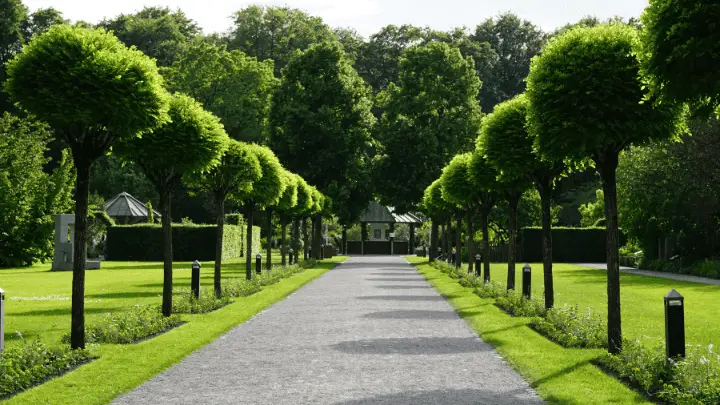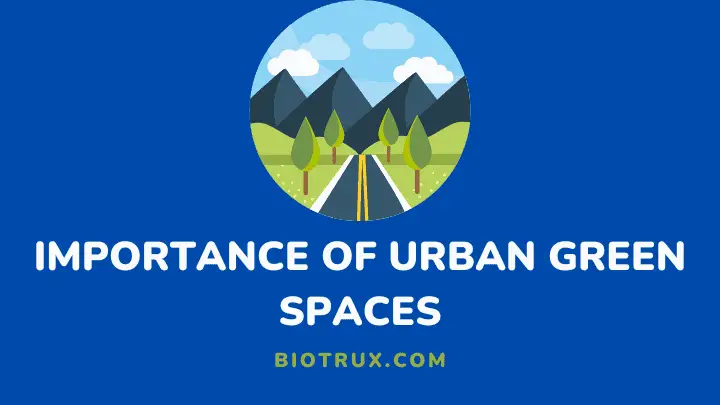As our cities grow and expand, recognizing the importance of urban green spaces is becoming increasingly vital. The beauty of these natural areas provides a breath of fresh air among the concrete jungle, allowing us to connect with nature and reap tremendous benefits.
Urban green spaces have been shown to improve air quality, reduce stress levels, and even boost productivity and creativity. It’s time to prioritize creating and preserving urban green spaces for all as the potential effects of climate change and environmental degradation threaten.
Join me as I explore the importance of urban green spaces and how they enrich our lives.
1. Improved Air Quality
Improving air quality is one of the most significant importance of urban green spaces. Urban areas are often characterized by high pollution levels, mainly caused by vehicular emissions, industrial activities, and other human-related activities.
This pollution can negatively impact our health, leading to respiratory diseases, asthma, and other related illnesses. Fortunately, green spaces, such as parks, gardens, and other natural areas, can help reduce pollution and improve air quality in urban environments.
Plants and trees absorb carbon dioxide and other harmful air pollutants, releasing oxygen into the atmosphere. The development and maintenance of green spaces in urban environments will increase as more people learn about the benefits of these areas.
2. Biodiversity Enhancement
Urban green spaces are crucial in maintaining and enhancing biodiversity in urban areas. These spaces serve as natural habitats for various species of plants, birds, insects, and small animals, which help maintain a healthy ecosystem.
Trees, plants, and other vegetation in these green spaces attract pollinators, which help in plant reproduction and fresh air production. The diversity of plant species in these green spaces provides food and shelter for various animals, including birds and insects.
This leads to a balance in the food chain and ultimately promotes a healthy and diverse ecosystem. Therefore, preserving and protecting urban green spaces is essential as they provide various ecological and social benefits.
3. Mitigating the Effects of Urban Heat Islands
Urban heat islands are phenomena where temperatures in urban areas are higher than in rural areas due to the concentration of buildings, vehicles, and people. This can lead to various problems, including higher energy consumption, increased air pollution, and public health risks.
By providing shade, cooling the air through transpiration, and reducing heat absorption by structures and buildings, green urban spaces can help counteract these effects. Trees, in particular, lower urban temperatures and improve living conditions for people.
Overall, the importance of urban green spaces in mitigating the effects of urban heat islands cannot be overstated. Green spaces are vital for livable, sustainable, and resilient cities.
4. Community Interaction and Social Cohesion
Urban green spaces, such as parks, gardens, and open fields, significantly enhance community interaction and social cohesion. These spaces provide a gathering place for people of all ages and backgrounds, fostering social connections and promoting a sense of belonging.
People with access to urban green spaces are more likely to engage in picnics, sports, and other leisure activities. This promotes social interactions and helps build stronger social ties within communities.
Additionally, green spaces provide a space for community events, such as festivals and concerts, which bring people together and strengthen community bonds. Green spaces also provide opportunities for physical activity, which can improve overall health and well-being.
People who exercise together in green spaces are more likely to build relationships, further promoting community interaction and social cohesion.
5. Increased Mental Health and Well-being

There is no denying the importance of green spaces in urban areas significantly impacting our mental health and well-being.
Several studies have found a positive correlation between spending time in green spaces and improved mood, reduced stress levels, and increased overall well-being.
Being surrounded by nature, even if it’s just a small patch of grass, can calm the mind and help us feel more relaxed and refreshed. Green spaces escape urban noise and chaos, offering a peaceful, serene environment to relax and unwind.
Moreover, spending time in green spaces has been linked to lower rates of depression and anxiety and can also improve cognitive function. Studies have shown that people who regularly spend time in nature have better attention spans and are more productive at work.
6. Educational Opportunities
Aside from providing a relaxing and serene atmosphere, urban green spaces can offer various educational opportunities. Parks, botanical gardens, and nature reserves can serve as excellent outdoor classrooms where visitors can learn about local flora and fauna.
These green spaces can provide hands-on experiences that deepen individuals’ understanding and appreciation of the natural world. Through interpretive signage, guided tours, and educational programs, urban green spaces can educate people about environmental conservation, biodiversity, and sustainability.
These spaces can be used for nature-based school learning, connecting students to the environment. Urban green spaces can also serve as an important cultural and historical education source.
Some parks and gardens may have monuments or statues commemorating significant events or individuals. Others may offer guided tours that showcase local art, music, or cuisine.
7. Increased Property Aesthetics and Tourism Appeal

Urban green spaces are vital for various reasons, and one peculiar importance is the increased property aesthetics and tourism appeal they offer. Whether you are a property owner or a tourist, green spaces can enhance your experience of a place in numerous ways.
Firstly, green spaces add a beautiful touch to any property or urban area, which can increase property aesthetics. Being surrounded by lush greenery and beautiful gardens creates a sense of serenity and tranquillity.
Additionally, green spaces play a crucial role in tourism appeal. People love to travel to places that offer a unique and enjoyable experience. Urban green spaces can provide visitors with a natural oasis amid the hustle and bustle of a city.
This makes for a relaxing and refreshing experience that people are more likely to want to return to. Places like New York’s Central Park or London’s Hyde Park are famous examples of urban green spaces that have become tourist hotspots in their own right.
8. Climate Regulation and Adaptation
Urban green spaces play an essential role in regulating the climate and adapting to changes brought about by climate change. Cities are becoming increasingly crowded, creating urban heat islands, causing urban areas to be hotter than nearby rural areas.
Green spaces, such as parks and gardens, provide shade and cooler temperatures, reducing the overall temperature of cities and mitigating the heat island effect. In addition to regulating the climate, urban green spaces can help adapt to climate changes.
As extreme weather events like heat waves and heavy rain become more frequent, green spaces can help absorb and store excess water, reducing flooding risk. They also help to improve air quality, as trees and plants absorb pollutants and release oxygen.
9. Urban Food Production
With the rise of urban farming, cities are taking advantage of their green spaces to produce fresh and organic food for the local community. Urban farming can take many forms, from community gardens to rooftop farms, and it offers several benefits.
Firstly, it provides a source of fresh produce accessible to urban residents who may not have access to green space or affordable fresh produce. It also reduces food transportation costs and carbon emissions associated with the transportation of food.
Furthermore, urban farming promotes food security and resilience by encouraging local production and reducing dependence on imported food. It also creates local jobs and economic opportunities, particularly in communities with high unemployment or poverty rates.
10. Economic Savings
One of the often-overlooked importance of urban green spaces is the potential for economic savings. Green spaces, such as parks and gardens, provide numerous economic benefits that can positively impact local communities.
Firstly, green spaces can help to reduce energy consumption. Trees and vegetation provide shade, reducing the need for air conditioning in hot weather. This can lead to significant savings in energy costs, especially in densely populated urban areas.
In addition to energy savings, green spaces can also boost property values. Properties with easy access to green spaces like parks or gardens are often more desirable and command higher prices.
This is because green spaces are known to impact mental and physical well-being positively and are seen as desirable for homeowners. Furthermore, green spaces can help to reduce healthcare costs.
Studies have shown that spending time in nature can positively impact mental health, reducing stress and anxiety. This can lead to lower healthcare costs as individuals may require less medical intervention.
FAQs
What are the economic benefits of urban green spaces?
Urban green spaces have economic benefits for cities. They attract visitors, boosting tourism and local businesses. Properties near green spaces often have higher values, contributing to the economic growth and desirability of the area.
How can urban green spaces help in reducing noise pollution?
Urban green spaces, particularly those with dense vegetation, can act as natural sound barriers, absorbing and deflecting noise. Trees and plants help to mitigate noise pollution by blocking sound waves and creating a quieter and more peaceful environment within cities.
Can urban green spaces help mitigate the effects of urbanization on water quality?
Yes, urban green spaces play a role in mitigating the effects of urbanization on water quality. Vegetation helps to filter and purify rainwater, reducing the amount of pollutants that enter water bodies. By incorporating green infrastructure, such as rain gardens and bioswales, cities can effectively manage stormwater runoff and improve water quality.
What are the social benefits of urban green spaces for children and families?
Urban green spaces offer numerous social benefits for children and families. They provide safe and accessible places for children to play, explore, and connect with nature. Families can bond and spend quality time in these outdoor environments, promoting well-being and family cohesion.
Final Thoughts
Urban green spaces are crucial in promoting a healthy and sustainable environment in our cities as they offer a range of benefits. As urbanization continues to grow, prioritizing developing and maintaining green spaces in our cities is more important than ever.
Cities investing in green infrastructure have seen tangible benefits, such as increased property values and economic growth. Investing in urban green spaces can make our cities more resilient and sustainable for future generations.
In conclusion, urban green spaces are both a luxury and a necessity. They are vital in creating livable, healthy, and sustainable cities that benefit everyone there. As such, we must continue to prioritize and invest in their development and maintenance to ensure a brighter and healthier future for our cities and our planet.
I hope you enjoyed reading this article. You can also learn more about how smart cities are sustainable.
Thanks for reading.

